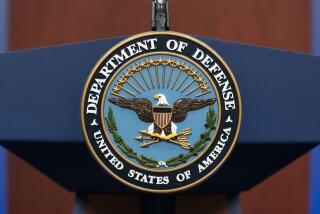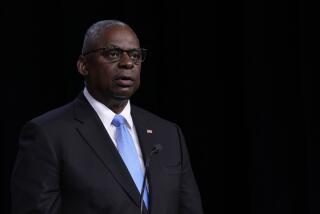WHO’S COMMANDING U.S. FORCES IN THE GULF
- Share via
Gen. H. Norman Schwarzkopf, 56. Commander in chief of the Central Command, which is responsible for military operations in the Middle East. Referred to as “Stormin’ Norman” and “The Bear” by his troops--references to his volatile temper and his 6-foot-3 frame. A West Point graduate, trained as an infantryman, Schwarzkopf commanded the 24th Infantry Mechanized Division and was second-in-command of U.S. troops that stormed Grenada in 1983. “A dirty-boots warrior--not a political general by any stretch of the imagination,” said one Army officer.
Lt. Gen. Charles A. Horner, 54. Commander of U.S. forces deployed in Saudi Arabia during Operation Desert Shield. He commands the 9th Air Force, which trains to fight in the Middle East, from Shaw Air Force Base, S.C. A veteran of 111 combat missions over North Vietnam, “Chuck” is known for the back-slapping sense of humor expected of a “good stick.” A fighter jock equally at home in the cockpit of an F-16 Falcon, an F-15 Eagle or a Vietnam-vintage F-4, Horner is noted for his love of golf and his steadiness.
Rear Adm. William M. Fogarty, 54. Commander of the U.S. Navy’s Joint Task Force, Middle East, overseeing the Navy’s growing armada of warships--now numbering 23--in the Red Sea, Arabian Sea and Persian Gulf. From aboard the flagship La Salle, Fogarty commanded U.S. ships escorting Kuwaiti tankers in the final days of the Persian Gulf reflagging operation. Fogarty was also skipper of the battleship New Jersey in 1983, when its 16-inch guns pounded the mountains of Lebanon. The gunfire was criticized for its lack of precision.
Maj. Gen. James H. Johnson Jr., 52. Commander of the 82nd Airborne Division that sent the first U.S. troops ever into Saudi Arabia last week. A battle-tested commander, Johnson was the first man out the door when his elite paratroop outfit jumped into battle in Panama. “He’s cool under fire--a cool customer,” said one Army officer who has worked with the native Alabamian. Trained as an infantry officer, Johnson has moved in and out of the Army’s airborne commando units throughout his career.
Brig. Gen. J.H. Binford Peay III, 50. Commander of the 101st Airborne Air Assault Division, among the first units to arrive in Saudi Arabia. “Binnie” Peay “grew up” with the elite commando unit, taking part in its plans and training as a rapid-deployment force for use in the Third World. A Southern gentleman who trained as an artilleryman, Peay was chagrined, according to colleagues, that his unit was not used in Panama. Behind his mannerly exterior, colleagues say, is a warrior anxious to show in this operation what his division can do.
Maj. Gen. Barry R. McCaffrey, 47. Commander of the 24th Infantry Mechanized Division, the most heavily armed unit to arrive in Saudi Arabia so far. McCaffrey is described as the kind of expert soldier whose forte is teaching other soldiers how to fight. Known for his sharp intelligence, he was one of the early U.S. advisers to a Vietnamese airborne division. He later commanded a helicopter-borne cavalry company in Vietnam, where his arm was grievously wounded.
More to Read
Sign up for Essential California
The most important California stories and recommendations in your inbox every morning.
You may occasionally receive promotional content from the Los Angeles Times.














